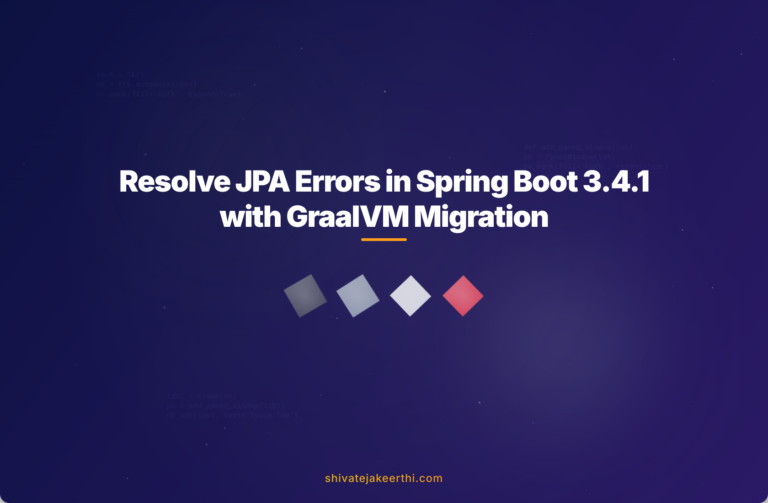Migrating your Java-17 Spring Boot project to GraalVM can give your application noticeable performance benefits. With Spring Boot 3.4.1, using GraalVM Liberica-NIK-23.0.7-1, many developers aim for faster startup times and reduced memory consumption. However, one common roadblock you might encounter is the infamous “Not a Managed Type” error when working with JPA Repositories.
If you’re scratching your head over this error, you’re certainly not alone. Many developers run into JPA-related hiccups while making the switch. Let’s shed some light on what exactly causes the issue, how it can impact your application, and more importantly, how you can resolve it efficiently.
Understanding the “Not a Managed Type” Error
If you’ve seen this error message recently, you’re familiar with the confusion it brings. Typically, Spring throws an error that clearly states something along the lines of:
java.lang.IllegalArgumentException: Not a managed type: class com.example.yourapp.domain.ConfigLog
In simple terms, this error occurs because Spring’s JPA context doesn’t recognize your entity class (ConfigLog in this case). It means Spring considers that the entity class is not registered as a managed type, so it doesn’t know how to persist it into your database.
Usually, the stack trace provides clues pointing towards issues in your configuration, entity setup, or repository definitions. It’s essential to read through carefully, as the entire JPA functionality depends on correctly configured entities and repositories.
The main implication of this error is that your application’s persistence layer stops functioning entirely. This leads to endpoints failing, services crashing, and your application becoming unusable.
Investigation and Troubleshooting Steps
When faced with the “Not a Managed Type” error during your GraalVM migration, it’s best to start at the most probable locations in your codebase:
Checking the DatabaseConfiguration Class
Your DatabaseConfiguration class is often a good starting point. In Spring Boot, a typical mistake is forgetting the entity scanning annotation or incorrect paths in the configuration.
Check if you’ve properly annotated the configuration class or your main application class with something like:
@EntityScan(basePackages = "com.example.yourapp.domain")
@EnableJpaRepositories(basePackages = "com.example.yourapp.repository")
public class DatabaseConfiguration {
// Database setup code here
}
Make sure the specified package paths exactly match where your entities and repositories reside.
Reviewing the ConfigLog Entity Class
Next, ensure your entity class looks correct to Spring JPA. Typical entity classes should have clear, standard annotations such as @Entity and @Table:
package com.example.yourapp.domain;
import jakarta.persistence.Entity;
import jakarta.persistence.Table;
import jakarta.persistence.Id;
@Entity
@Table(name = "config_log")
public class ConfigLog {
@Id
private Long id;
private String message;
// Getters, setters, constructors
}
A common mistake here is using incorrect import statements. Remember, in modern Spring Boot 3.x, the correct Jakarta EE namespace jakarta.persistence.* must be used instead of javax.persistence.* to avoid compatibility issues.
Examining the ConfigLogRepository Class
Next, confirm your Repository interface is correctly defined. Following best practice, it should extend JpaRepository and define the domain type and primary key type clearly:
package com.example.yourapp.repository;
import org.springframework.data.jpa.repository.JpaRepository;
import com.example.yourapp.domain.ConfigLog;
public interface ConfigLogRepository extends JpaRepository<ConfigLog, Long> {
// Custom query methods, if necessary
}
Double-check your import statements and ensure consistency throughout all your repository classes.
Solutions and Workarounds to Fix the Error
After thorough investigation, here are actionable steps you can implement to resolve the “Not a Managed Type” issue effectively:
- Double-check Package Scanning Annotations: Ensure correct and complete packages in the
@EnableJpaRepositoriesand@EntityScanannotations. A slight typo here can break your entire persistence setup. - Verify Entity Registration: Confirm entity setup, annotations (
@Entity,@Table,@Id), and proper imports from the correct Jakarta namespace. - Spring Boot Application Alignment: Consider using package alignment where your entities, repositories, and main application class share a common base package. This simplifies entity scanning and reduces possible misconfigurations.
- Review Dependencies & Compatibility: Sometimes, dependency versions can conflict. Check carefully with the official Spring Boot compatibility matrix for your JPA provider (such as Hibernate), Spring Boot, and GraalVM.
Best Practices for Successful GraalVM Migration
While the “Not a Managed Type” error can arise, keeping certain best practices in mind will enhance your migration success:
- Start Small & Test Regularly: Don’t migrate all at once. Incrementally test smaller modules to isolate and fix compatibility issues early.
- Utilize GraalVM Native Image Tools: Tools provided by GraalVM help you analyze your app performance and compatibility. Familiarize yourself with GraalVM’s official documentation and its available tools.
- Avoid Reflection Where Possible or Configure It Clearly: GraalVM in native-image mode requires explicit reflection configuration. Make sure your entities, repositories, and any reflective operations are properly defined inside reflection configuration files.
- Test Persistence Interaction Thoroughly: Perform comprehensive integration tests to ensure JPA and database connectivity works as expected before moving further.
- Monitor Performance Improvements: Use profiling tools after migration to analyze memory consumption and startup times. You want visible performance gains through GraalVM.
Avoiding these common pitfalls ensures your migration runs smoother and more predictably. For optimizing JavaScript interactions within your Java-based backend, you might find some insightful tips in this JavaScript articles category page.
The journey of migrating to GraalVM with Spring Boot can indeed present errors like “Not a Managed Type,” but rest assured, they are solvable with structured troubleshooting.
Now that you’re equipped with insights into why this error occurs and how you can resolve it, we hope your migration to GraalVM becomes more manageable.
Have you encountered other challenging issues while migrating to GraalVM with Spring Boot? Share them in the comments below!



0 Comments